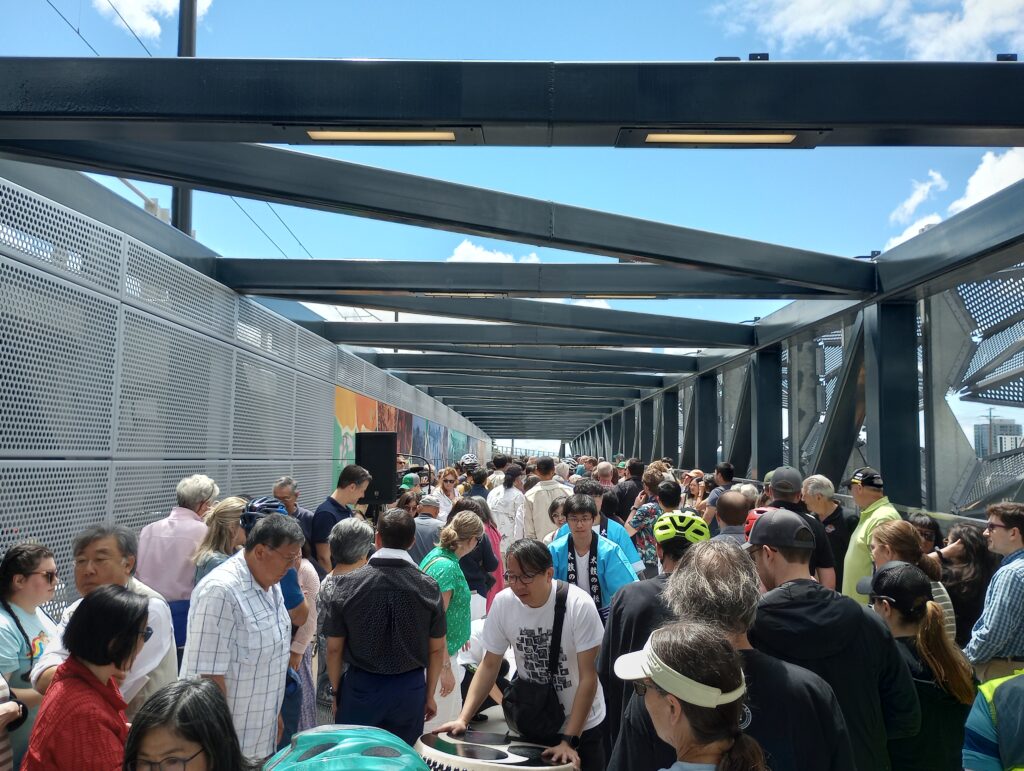NE 8th Bridge Opens in Bellevue

This past Sunday, community gathered in Bellevue to cut the ribbon on the next section of Eastrail, the NE 8th Bridge. With newly opened light rail trains passing overhead, onlookers heard from elected officials, King County Parks staff, and descendants of the Japanese American community that once farmed the land where the new Eastrail bridge opened.
The bridge provides an important connection both for trail users connecting into Wilburton (and bypassing high speed traffic on NE 8th), as well as for transit users departing Wilburton Station, which sits immediately east of the bridge. The bridge brings the Eastrail one step closer to a fully connected corridor in Bellevue, and is a great example of how Eastrail is more than just a trail, but a key piece of multimodal transit for the region.

As part of the ribbon cutting, powerful, thought-provoking pieces of art that are part of the bridge iteself were unveiled. Led by Isan Bellevue, King County Parks also took this opportunity to recognize and highlight the experiences of Japanese Americans in Bellevue. Artists Lauren Iida, Akiko Sogabe, Erin Shigaki and Mari Shibuya, along with poet Lawrence Matsuda, installed multiple pieces as you approach, and a mural that runs the length of the bridge and includes imagery, stories, and history about the Japanese American community, as well as other historically marginalized groups on the Eastside. The pieces are worth a visit on their own, and we hope that trail users will pause to learn and reflect on the history of the area they’re passing through.
Amy Hirotaka representing Isan Bellevue shared, “Immediately adjacent to where we stand (on the site of the Wilburton light rail station) was the Bellevue Growers Association packing and shipping house, built in 1933. This location served as an agricultural hub for Japanese American farmers, where they packed and shipped their produce (tomatoes, peas and lettuce in particular), all across the country, contributing to the economic vitality of the region until their forced removal and incarceration during World War II. Some families returned after the war, and many did not. Those that did found burned-down homes and barns, fallow fields, and signs using racial slurs instructing them to ‘go home.’ Their years-long incarceration had lasting impacts that have resonated for generations. Despite the trauma and hardship—and ever-present racism—Japanese American families endured and even thrived in Bellevue.”
“These art installations bring to light important local history that has been overlooked for too long,” said King County Councilmember Claudia Balducci. “They help tell the story of Japanese Americans in Bellevue, from hard work, prosperity, and community to discrimination, incarceration, and resilience. It’s been an honor to help guide this project from its inception to fruition and I am deeply grateful to Isan Bellevue and the Japanese community, as well as our partners at King County Parks, for leading this powerful effort to uplift the stories of the Japanese American community that helped shape the City of Bellevue.”
Eastrail Partners was excited to lead a bike ride from the Totem Lake neighborhood to the bridge opening, supported by volunteers from Livable Kirkland and Eastside Urbanism. Over 50 people on bikes joined us to ride together on the Eastrail to the opening, and were some of the first bikers passing over the bridge after the ribbon cutting.

For now, the trail terminates at NE 4th in Bellevue. A short extension south in Wilburton is slated to open in 2025, followed by the full opening of the Wilburton Trestle and 405 crossings in 2026, which will bring the Eastrail all the way to 118th near the Mercer Slough. Until that time, there are limited dedicated bike connections in Bellevue from the trail’s terminus at NE 4th. Eastrail Partners is working on resources for those hoping to continue south, while continuing to advocate for more safe bike infrastructure connecting the trail to community in Bellevue.
Read More:
- New King County Parks bridge connects Eastrail to Sound Transit’s Wilburton Station, offering safe, convenient access to trail and rail in Bellevue – King County, Washington
- New Bellevue bridge linking trail with light rail opens Sunday | The Seattle Times
- NE 8th Street Eastrail bridge opening June 23 – Seattle Bike Blog
- Eastrail’s NE 8th Street Bridge Opens in Bellevue’s Wilburton Neighborhood – The Urbanist